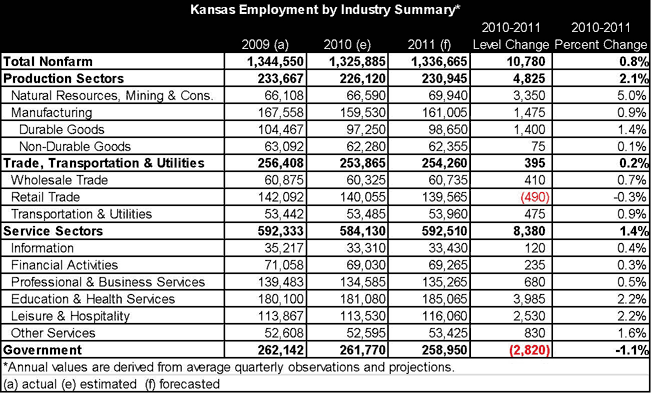National employment declined 4.3 percent in 2009. Employment declines are expected to end in 2010, with little to no growth expected until 2011. Strengths of the national economy include increased manufacturing activity, declines in initial unemployment claims in September 2010, and increases in quarterly corporate profits. At the same time, continued unemployment claims have remained high and housing and mortgage markets continue to falter. While nationally, the end of the great recession seems hazy, the signs locally have been clearer.
The Kansas unemployment rate was 6.9 percent in July 2010. The unemployment rate began to decline in August 2009 after reaching 7.9 percent in July of the same year. As of this writing, Kansas employment is on track to decrease 1.4 percent in 2010, after declining 3.3 percent in 2009.
Creighton University’s Business Conditions Index for Kansas fell below 50 and remained below 50, indicating economic contraction, in November 2008. Signs of strength began to appear in September and October 2009 when the index reached 50 for the first time in nearly a year. Creighton University’s Index grew nearly 15 points from January through May 2010. The Index is on track to remain above 50. Since fall 2009 the Index has occasionally faltered, but continued its upward progress. Purchasing prices of businesses, consumer confidence, new orders, and delivery lead time have led the Kansas Index, with purchasing prices of businesses outperforming the Midwest region and that of the U.S. since March 2010. Although some manufacturing indicators declined in July 2010, most recovered in August
In addition to manufacturing indicators in the Creighton Index, signs of economic weakness in Kansas for the 12 months ending June 2010 compared to conditions in the 12 months ending June 2009 include:
- A decline of 3.3 percent in non-farm wage and salary employment at Kansas businesses, representing a loss of 45,000 jobs.
- A loss of more than 23,800 jobs in the goods producing sector, for a decrease of about 9.5 percent over 12 months. Nearly 40 percent of those jobs were at transportation equipment manufacturing companies.
- An increase in the unemployment rate of 1.1 percentage points, to 6.8 percent for the year ending June 2010, up from 5.7 percent one year earlier. Total numbers of the unemployed were up 16,780 for the year ending June 2010.
- A decline of $0.42 in the average hourly earnings of a manufacturing employee between June 2009 and June 2010, indicating continued weakness in the manufacturing sector.
The CEDBR has observed signs of recovery on the horizon.
- Tax collection exceeded Kansas expectations in August by more than 10 percent. Retail sales tax collections were 18 percent higher than expected, totaling $169 million.
- The number of hours worked in manufacturing has increased from 39.3 in June 2009 to 41.8 in June 2010. Increased work hours tend to precede employment gains.
- The number of outbound air passengers increased 3.1 percent at Wichita’s Mid-Continent Airport, while increasing 2.1 percent at Kansas City’s International Airport, in the first half of 2010.
The indicators, when taken together, point to a year of slowing decline in 2010, with limited growth next year in Kansas. In 2011 Kansas employment is projected to increase 0.8 percent, gaining approximately 10,780 jobs.
The industry segments that are expected to contract in 2011 include:
- Retail trade, down 0.3 percent for a loss of 490 jobs
- Government, down 1.1 percent, as temporary Census employees and American Recovery and Reinvestment Act funded employees are shed
The largest expanding segments of Kansas’ economy in 2011 are forecasted to be:
- Education and health services, up 2.2 percent for a net gain of 3,985 jobs
- Natural resources, mining and construction employment, up 5 percent for a net gain of 3,350 jobs
- Leisure and hospitality services, up 2.2 percent for a net gain of 2,530 jobs
The Kansas economy is expected to continue its sluggish employment rebound in the remainder of 2010. In 2011, employment will continue to rebound, picking up some of the losses from the great recession. Full employment recovery is not expected to be achieved until after 2012. The increased pace of recovery, in 2011, is reflected in the Kansas forecast.


